Thpok-independent repression of Runx3 by Gata3 during CD4+ T-cell differentiation in the thymus
- PMID: 23310955
- PMCID: PMC6319927
- DOI: 10.1002/eji.201242944
Thpok-independent repression of Runx3 by Gata3 during CD4+ T-cell differentiation in the thymus
Abstract
CD4(+) helper T cells are essential for immune responses and differentiate in the thymus from CD4(+) CD8(+) "double-positive" (DP) thymocytes. The transcription factor Runx3 inhibits CD4(+) T-cell differentiation by repressing Cd4 gene expression; accordingly, Runx3 is not expressed in DP thymocytes or developing CD4(+) T cells. The transcription factor Thpok is upregulated in CD4-differentiating thymocytes and required to repress Runx3. However, how Runx3 is controlled at early stages of CD4(+) T-cell differentiation, before the onset of Thpok expression, remains unknown. Here we show that Gata3, a transcription factor preferentially and transiently upregulated by CD4(+) T-cell precursors, represses Runx3 and binds the Runx3 locus in vivo. Accordingly, we show that high-level Gata3 expression and expression of Runx3 are mutually exclusive. Furthermore, whereas Runx3 represses Cd4, we show that Gata3 promotes Cd4 expression in Thpok-deficient thymocytes. Thus, in addition to its previously documented role in promoting CD4-lineage gene-expression, Gata3 represses CD8-lineage gene expression. These findings identify Gata3 as a critical pivot of CD4-CD8 lineage differentiation.
© 2013 WILEY-VCH Verlag GmbH & Co. KGaA, Weinheim.
Conflict of interest statement
The authors declare no financial or commercial conflict of interest.
Figures
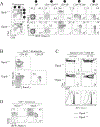
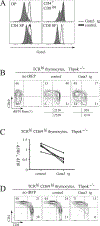

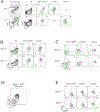
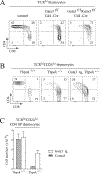
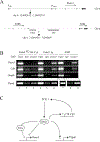
Similar articles
-
Runx3 regulates integrin alpha E/CD103 and CD4 expression during development of CD4-/CD8+ T cells.J Immunol. 2005 Aug 1;175(3):1694-705. doi: 10.4049/jimmunol.175.3.1694. J Immunol. 2005. PMID: 16034110
-
Overexpression of the Runx3 transcription factor increases the proportion of mature thymocytes of the CD8 single-positive lineage.J Immunol. 2005 Mar 1;174(5):2627-36. doi: 10.4049/jimmunol.174.5.2627. J Immunol. 2005. PMID: 15728469
-
Distinct functions for the transcription factors GATA-3 and ThPOK during intrathymic differentiation of CD4(+) T cells.Nat Immunol. 2008 Oct;9(10):1122-30. doi: 10.1038/ni.1647. Epub 2008 Sep 7. Nat Immunol. 2008. PMID: 18776904 Free PMC article.
-
CD4-CD8 lineage differentiation: Thpok-ing into the nucleus.J Immunol. 2009 Sep 1;183(5):2903-10. doi: 10.4049/jimmunol.0901041. J Immunol. 2009. PMID: 19696430 Free PMC article. Review.
-
CD4 CTL: living up to the challenge.Semin Immunol. 2013 Nov 15;25(4):273-81. doi: 10.1016/j.smim.2013.10.022. Epub 2013 Nov 15. Semin Immunol. 2013. PMID: 24246226 Free PMC article. Review.
Cited by
-
[Expression and clinical significance of runt-related transcription factor 3 in children with bronchiolitis].Zhongguo Dang Dai Er Ke Za Zhi. 2019 Oct;21(10):1005-1011. doi: 10.7499/j.issn.1008-8830.2019.10.010. Zhongguo Dang Dai Er Ke Za Zhi. 2019. PMID: 31642435 Free PMC article. Chinese.
-
Runx3-mediated transcriptional program in cytotoxic lymphocytes.PLoS One. 2013 Nov 13;8(11):e80467. doi: 10.1371/journal.pone.0080467. eCollection 2013. PLoS One. 2013. PMID: 24236182 Free PMC article.
-
Dysregulation of the TOX-RUNX3 pathway in cutaneous T-cell lymphoma.Oncotarget. 2019 May 3;10(33):3104-3113. doi: 10.18632/oncotarget.5742. eCollection 2019 May 3. Oncotarget. 2019. PMID: 31139323 Free PMC article.
-
Insights into Thymus Development and Viral Thymic Infections.Viruses. 2019 Sep 9;11(9):836. doi: 10.3390/v11090836. Viruses. 2019. PMID: 31505755 Free PMC article. Review.
-
GATA3: a master of many trades in immune regulation.Trends Immunol. 2014 Jun;35(6):233-42. doi: 10.1016/j.it.2014.04.002. Epub 2014 Apr 28. Trends Immunol. 2014. PMID: 24786134 Free PMC article. Review.
References
-
- Paul WE, (ed). Fundamental Immunology, 6th Edition. Lippincott Williams & Wilkins, Philadelphia: 2008.
-
- Bosselut R, CD4/CD8-lineage differentiation in the thymus: from nuclear effectors to membrane signals. Nat Rev Immunol 2004. 4:529–540. - PubMed
Publication types
MeSH terms
Substances
Grants and funding
LinkOut - more resources
Full Text Sources
Other Literature Sources
Molecular Biology Databases
Research Materials

